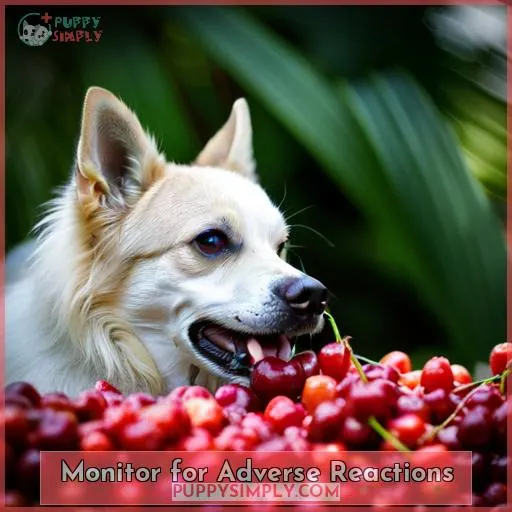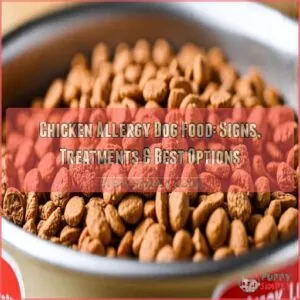This site is supported by our readers. We may earn a commission, at no cost to you, if you purchase through links.
 Connecting with canines is captivating, compelling, and caring.
Connecting with canines is captivating, compelling, and caring.
Can dogs consume cherries?
Contained within this article, you’ll encounter crucial insights regarding canine cherry consumption.
Discover the delightful benefits and daunting dangers lurking beneath this delectable fruit’s vibrant, crimson exterior.
Delve into the depths of cherry-related topics, ranging from permissible portions to perilous pitfalls.
Unravel the secrets of safe cherry preparation, ensuring your furry friend’s culinary journey remains enjoyable and devoid of distress.
Table Of Contents
- Key Takeaways
- Are Cherries Safe for Dogs?
- Health Benefits of Cherries for Dogs
- Dangers of Cherries for Dogs
- How to Prepare Cherries for Dogs
- Safe Ways to Feed Dogs Cherries
- Daily Recommended Cherry Intake
- Monitor for Adverse Reactions
- Seek Help if Cherry Poisoning Occurs
- Consult Your Veterinarian
- Frequently Asked Questions (FAQs)
- Conclusion
Key Takeaways
- Cherries contain vitamins and antioxidants that can benefit dogs, but pits/stems/leaves are toxic.
- Remove pits, stems, and leaves before giving dogs cherries to avoid cyanide poisoning.
- Introduce cherries slowly and in small amounts to watch for allergic reactions or upset stomachs.
- Stick to safe cherry options like frozen, pitted fresh cherries or commercial treats made for dogs.
Are Cherries Safe for Dogs?
When it comes to feeding your dog cherries, you’ll want to know if they’re safe for Fido or if you should avoid them altogether.
Cherries themselves aren’t toxic for dogs and can make nutritious training treats or snacks due to their antioxidant content.
However, the pits, stems, and leaves contain cyanide and must be removed.
Introduce cherries slowly and in small quantities to watch for allergies or intestinal upset.
Excess cherries could also lead to an intestinal blockage if pits are swallowed.
If you notice any concerning symptoms after feeding cherries, stop immediately and contact your vet.
Consider healthier cherry alternatives like commercial treats made specifically for canine consumption.
Health Benefits of Cherries for Dogs
Cherries actually offer some great nutritional value for your pup!
They contain vitamins A and C, antioxidants, melatonin, fiber, and potassium – all of which provide health perks from immunity boosts to better digestion.
However, you must be extremely careful to avoid the toxic parts we’ll examine.
Vitamin Boosts for Pups
You’re giving your dog antioxidants, fiber, melatonin, vitamins A and C with some cherries.
These nutrients can serve as:
- Training Treats
- Canine Vitamins
- Healthy Snacks
Cherries provide puppies and dogs key vitamins as part of a balanced, nutrient-rich diet when fed properly.
Toxic Parts to Avoid
However, you must avoid feeding dogs the pits, stems, and leaves of cherries. These parts contain cyanogenic glycosides that release cyanide when ingested. This compound is extremely toxic to dogs and can result in severe poisoning or even death if large amounts are consumed.
| Cherry Part | Toxic Compound | Symptoms |
|---|---|---|
| Pits | Cyanide | Labored breathing, dilated pupils |
| Stems | Cyanide | Vomiting, seizures |
| Leaves | Cyanide | Loss of appetite, bright red gums |
Moderation is Key
Moderation’s crucial when giving your pup cherries since too many can upset their stomach.
Nutritional Benefits
Portion Control
Flavorful Alternatives
Controlling portions allows your pup to enjoy cherries’ nutritional benefits without stomach upset.
Offer creative treats like frozen cherries or plain yogurt with cherry pieces instead of too many fresh cherries, which have high sugar content.
Watch for signs of trouble like decreased appetite, rapid breathing, or red gums that mean it’s time to stop cherries.
Dangers of Cherries for Dogs
However, you must exercise caution when feeding cherries to dogs.
The pits, stems, and leaves contain cyanide, which can cause poisoning.
The pits also pose a risk of intestinal obstruction if swallowed.
Cyanide Poisoning
If you feed your dog cherry pits, stems, or leaves, it can lead to cyanide poisoning.
Watch for symptoms like dilated pupils, vomiting, seizures, or trouble breathing.
This dangerous condition requires immediate veterinary care.
Stick to safe cherry options like frozen cherries or commercial treats.
And remember – no maraschino cherries, which contain toxic preservatives unsuitable for dogs.
Intestinal Blockage
You must also watch for intestinal blockages from cherry pits your dog swallows. This can lead to:
- Vomiting
- Loss of appetite
- Constipation
- An obstructed digestive tract.
Preventing blockages requires dietary caution – peel, pit, and chop cherries before mixing into a homemade cherry fruit smoothie or stuffing into a Stāk Kong toy.
If an obstruction occurs, seek emergency veterinary guidance.
How to Prepare Cherries for Dogs
When preparing cherries to give to your dog:
- Remove the pits, stems, and leaves, as they contain cyanide.
- Thoroughly wash the cherries.
- Cut them into small, bite-sized pieces to prevent choking.
By following these steps, you can safely allow your dog to enjoy the benefits of this sweet, antioxidant-rich fruit.
Remove Pits, Stems and Leaves
You’re now ready to prepare cherries for your dog after removing the dangerous parts.
Start by taking off the pits, stems, and leaves from each cherry before giving them to your dog.
| Pit Safety | Stem Removal | Leaf Hazards |
|---|---|---|
| Remove all pits from cherries as they contain cyanide, which is toxic to dogs. | Carefully remove stems from each cherry before feeding them to your dog. | Ensure that no leaves are left on the cherries as they can be hazardous for dogs if ingested. |
Wash Thoroughly
Before feeding cherries to your dog:
- Thoroughly wash the fruit to remove any pesticides, dirt, or debris that could be harmful.
- Run them under cool water and gently rub each cherry.
- Inspect for any remaining pit fragments or stems and discard those to avoid intestinal issues.
Thorough washing protects your pup while allowing them to enjoy the canine antioxidants and frozen delights cherries can provide.
Cut Into Small Pieces
One should cut cherries into bite-sized pieces before feeding them to dogs to reduce choking hazards.
Even small breeds may struggle with whole cherries.
Cutting the fruit helps release nutrient-rich juices while allowing adjustable serving sizes.
Consult your veterinarian about introducing cherries, especially if your dog has food allergies.
Some dogs enjoy frozen or fresh cherries, but recipes using chopped cherries can maximize nutritional benefits.
Safe Ways to Feed Dogs Cherries
When feeding cherries to your dog, stick to safe options:
- Frozen cherries
- Fresh cherries with pits removed
- Commercial cherry treats made for dogs
Avoid giving your dog:
- Maraschino cherries, as they contain high sugar
- Wild cherries, which have higher cyanide levels
Introduce any new treats slowly and monitor your dog for any adverse reactions.
Frozen Cherries
Serve your dog some frozen cherries as a cool, teething treat.
These frozen treats make refreshing summer snacks.
When preparing homemade recipes with fruit alternatives for dogs, be mindful of canine allergies.
Monitor your pup closely for reactions.
Fresh Cherries
You can also feed your dog fresh cherries as a healthy treat, but be sure to remove the pits and stems first.
Use fresh cherries when making healthy cherry recipes packed with canine antioxidants for summer treats and healthy dog snacks—just remember fruit safety comes first when preparing cherries.
Commercial Dog Treats
Through commercial dog treats specifically made with cherries, you’re able to ensure your pup gets to enjoy the fruit’s benefits without the dangers of cyanide exposure.
Look for brands using fruit deemed safe by veterinarians.
Create healthy homemade recipes with seasonal cherries and other nutritional alternatives for DIY dog treats.
Daily Recommended Cherry Intake
When feeding cherries to your dog, moderate the quantity based on their size. Treats should only comprise 10 percent of a dog’s daily caloric intake to maintain nutritional balance.
Puppies have more sensitive digestive systems, so extra caution is advised.
Adult dogs can have 1-5 cherries depending on weight, but those with diabetes, obesity, or cherry allergies should avoid them.
Regardless of age or size, introduce cherries gradually while monitoring for adverse reactions. Portion control is key – consult your veterinarian to determine appropriate cherry quantities for your dog’s individual health.
Monitor for Adverse Reactions
After feeding cherries to your dog, keep an eye out for signs of digestive upset or allergic reaction.
Look for symptoms like:
- Vomiting
- Diarrhea
- Loss of appetite
- Lethargy
- Scratching
- Swelling
These could indicate intolerance or a reaction.
Carefully observe your dog’s health and behavior for at least a couple hours post-cherry consumption.
Document any concerning symptoms and call your vet right away if serious signs appear.
Having an emergency response plan ready allows you to get prompt care.
Through diligent reaction monitoring and being aware of potential adverse effects, you can get treatment if warning signs arise.
Stay vigilant about your pet’s health observations when introducing new foods.
Seek Help if Cherry Poisoning Occurs
If cyanide poisoning occurs after your dog eats cherries, how fast can you get veterinary help? Prompt treatment greatly improves chances for recovery, so waste no time rushing your dog to the vet or an emergency animal hospital if you notice symptoms like:
- Dilated pupils
- Labored breathing
- Bright red gums
- Vomiting
- Seizure
Call animal poison control hotline for emergency protocols.
Rush dog to vet clinic or emergency animal hospital.
Closely monitor symptoms and vital signs.
Getting fast veterinary attention is critical, as the vet can provide oxygen therapy, antidotes, and supportive care to treat cyanide poisoning.
Stay calm, be prepared to describe your dog’s symptoms, and follow the vet’s guidance to give your pup the best chance at recovery.
Consult Your Veterinarian
Before adding cherries into your furry friend’s meal plan, it’s essential that you schedule an appointment with your veterinarian.
Your veterinarian will provide guidance specific to your dog’s breed and individual needs. They can assess whether cherries are a suitable addition to your dog’s diet and help you determine the proper amount of cherries based on their size and overall health.
If your dog has any prior health conditions or is on medication, it’s important for the vet to review these factors before introducing cherries into their diet.
Regular routine vet checkups are also crucial for monitoring sugar intake and ensuring that your dog maintains a balanced and proper diet tailored specifically for them.
Frequently Asked Questions (FAQs)
Are cherries okay for puppies to eat?
Yes, puppies can eat small amounts of fresh cherries if you remove the pits, stems, and leaves first.
Introduce cherries slowly to avoid digestive upset from the sugar.
Monitor puppies closely, as their small stomachs are more sensitive.
Always exercise caution when feeding human foods.
What are symptoms of an allergic reaction to cherries in dogs?
You may notice:
- Scratching
- Hives
- Swelling
- Vomiting
- Diarrhea
- Excessive licking
- Trouble breathing
Consult a vet immediately if your pup has an adverse reaction.
Can dogs eat dried cherries or cherry products?
Yes, dogs can eat dried cherries or cherry treats made for dogs in moderation.
Avoid letting them ingest pits, stems, leaves, or excess sugar as it may cause health problems.
Monitor for reactions.
How long after eating cherries do symptoms of poisoning appear?
Symptoms usually appear within 30 minutes to 4 hours after ingestion.
Look for:
- Difficulty breathing
- Vomiting
- Lethargy
- Dilated pupils
- Bright red gums
Seek emergency veterinary care immediately if poisoning is suspected.
Are wild cherries safe for dogs to eat?
No, don’t feed wild cherries to dogs.
Wild cherries contain more cyanogenic glycosides than commercial cherries, making them toxic.
Even small amounts could be dangerous.
Stick to store-bought cherries without pits or stems.
Conclusion
You now comprehend the delights and dangers of sharing cherries with canines.
Monitor portions, remove toxic parts, and prep properly to let your dog savor this fruity treat safely.
Though cherries’ nutrients benefit pups, excess intake or ingesting inedible portions risks harm.
So enjoy feeding your furry friend an occasional cherry, but exercise caution.
Consult your veterinarian if questions or concerns arise regarding can dogs eat cherries.















